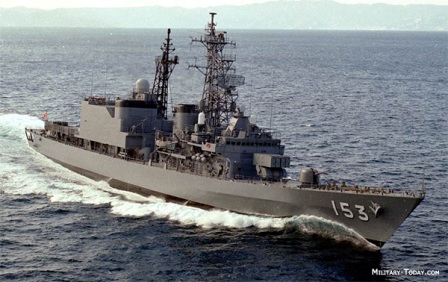Asagiri-class
Summary
| Origin country | 🇯🇵 Japan |
| Category | Destroyer |
| Subtype | Missile destroyer |
| Manufacturer | IHI Corporation, Hitachi Zosen Corporation, Sumitomo Heavy Industries, Mitsui Engineering & Shipbuilding, Mitsubishi Heavy Industries |
| Year commissioned | 1988 |
| Units | JS Asagiri, JS Yamagiri, JS Yūgiri, JS Amagiri, JS Hamagiri, JS Setogiri, JS Sawagiri, JS Umigiri |
| Current operators | 🇯🇵 Japan |
Description
The Asagiri-class destroyer is a class of general-purpose destroyers that form part of the Japan Maritime Self-Defense Force (JMSDF). This class was developed as the second class of first-generation general-purpose destroyers within the JMSDF, following the construction of the Hatsuyuki-class destroyer which began in fiscal year 1977. The decision to develop the Asagiri class was made to address the limitations in command, control, communications, computers, and intelligence (C4I) capabilities, resistance, and durability that were present in the earlier Hatsuyuki-class design, due to budget constraints. Consequently, Asagiri-class destroyers, which were built after fiscal year 1983, featured an evolved design with an expanded hull and enhanced equipment.
The Asagiri-class design utilized an enlarged hull type of the Hatsuyuki class, taking a shelter deck style approach. The upper structure was made from steel, and integration from the initial design phase overcame potential issues affecting movement performance. A COGAG (Combined Gas and Gas) propulsion system replaced the COGOG (Combined Gas or Gas) system used in the Hatsuyuki class. The Asagiri class was equipped with four Kawasaki-Rolls-Royce Spey SM1A gas turbines, enabling the destroyers to reach 26 knots using only two out of four engines, which provided significant benefits for submarine tracking.
In terms of equipment, the combat direction systems of the early Asagiri-class batch were equipped with the OYQ-6 which was later upgraded to the OYQ-7, integrating the OYQ-101 Anti-Submarine Warfare (ASW) Direction System. These ships were adapted for C4I purposes with installations like the MOF system terminal that utilizes Superbird SHF-SATCOM. For radar systems, the surface-search radars of this class were updated to OPS-28, and air-search radars were updated to OPS-14C in the earlier batch and OPS-24 3D radars in the latter batch, which also benefited from new electronic warfare support measures systems, specifically the NOLR-8.
The Asagiri-class weapon systems remained largely similar to its predecessor with some minor changes to the Fire Control System (FCS). A new SH-60J helicopter was introduced for deployment on these ships, necessitating the installation of a large capacity data link device for operational use. Although the hangar was enlarged enough to house two helicopters, only one helicopter is employed operationally.
Operational history of the class includes the conversion of two ships, Yamagiri and Asagiri, into training vessels, reflecting their continuous versatility and adaptation to the needs of the JMSDF. The operational fleet comprises a total of eight ships: JS Asagiri (DD-151), JS Yamagiri (DD-152), JS Yūgiri (DD-153), JS Amagiri (DD-154), JS Hamagiri (DD-155), JS Setogiri (DD-156), JS Sawagiri (DD-157), and JS Umigiri (DD-158). The class operates exclusively within the Japan Maritime Self-Defense Force.
Technical specifications
| Displacement | 4250 tons |
| Range | 11000 km at 20 knots |
| Crew | 220 members |
| Width | 14.6 m (47.9 ft) |
| Length | 137.0 m (449.5 ft) |
| Propulsion | 4 Rolls Royce SM-1 Spey gas turbines with a power of 53,900 hp total - 2 propellers |
| Armament | 1 Arsenal 130mm gun + 2 Kashtan CIWS 30mm + 12 Oniks 3M55 anti-ship missiles + 1 Shtil I SAM system + 4 533mm torpedoes + 1 SS-N-29/RPK-9 Medvedka-VE ASM system. |
| Maximum speed | 30 knots |
